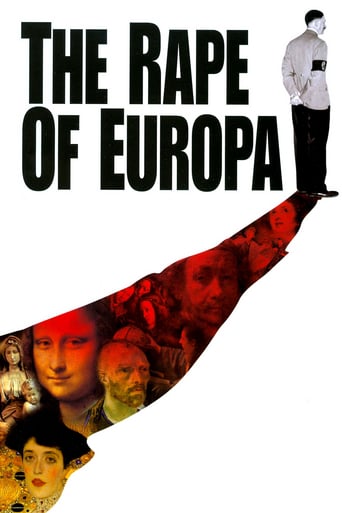TrueJoshNight
Truly Dreadful Film
Lollivan
It's the kind of movie you'll want to see a second time with someone who hasn't seen it yet, to remember what it was like to watch it for the first time.
Billy Ollie
Through painfully honest and emotional moments, the movie becomes irresistibly relatable
runamokprods
One of those documentaries that grows in impact as it goes along. For the first hour or so I found this study of the Nazi's plundering and stealing Europe's great works of art, along with the allies attempts to spare art during the war, intellectually interesting, but a bit dry and even repetitive. But as the film moves on to the aftermath of the war, and we get more of the human side of the story; great art treasures are returned to the lands whose cultures they represent and we see the joy that it brings, both sides of the Russian debate about keeping the art they took from Germany as a sort of reparation for the horrible human cost of the war, restorations still going on 60 years later with care and passion, a Christian German who has made it his mission to return beautiful and intricate Torah scroll caps to their rightful Jewish owners, the film blossoms into a very human examination of just how important art is to human beings and to our sense of selves. Ultimately, what starts feeling like a somewhat academic exercise ends up as a very moving and human documentary.
MartinHafer
This is a sad but fascinating documentary. While I knew that Nazis stole art throughout Occupied Europe, I didn't realize how systematic it was as well as the HUGE scope of the plundering. It wasn't just Goering (the most famous for his plundering) but Hitler and many of his henchmen that were behind the thefts--and they planned their invasions with plunder in mind! So, for example, when they thought art to be 'decadent' is was often destroyed--and when it was 'good', it was sent for German museums or to the private collections of these thieves! Today, some museums (such as in Vienna) talk at returning paintings to original families! Fortunately, some others (like the Utah museum) did return painting and acted responsibly when they learned that pieces of art in their collections were stolen by the Nazis. Other topics discussed in this interesting film were: The Soviet 'trophy brigades' returned the favor and plundered German museums and private collections--and today they STILL have the art and refuse to return it.That huge caches of art were found in mines as well as the famous Neuschwanstein Castle in Southern Bavaria.The ways that the Allies tried to avoid destroying art when they fought the Germans as well as efforts post-WWII to catalog and restore art to the rightful owners.It was very nice seeing Jewish people get back their silver 'Torah crowns'--and I found it very touching.Thousands of pieces of art are still missing--either destroyed or in private collections.All in all, a fascinating portrait of a seldom talked about but sick side of the Nazis--priceless art stolen from Holocaust victims and museums. Well worth seeing.
dprezny
I think somebody should make a documentary about the British Museum for starters. Let's count the artifacts there, they have looted. When the Prussians started to push the Germans back they took almost everything from the countries they marched trough. War is brutal and mindless. All war waging countries will loot & destroy. Growing up in eastern Europe I have a bit different opinion about WW2.I liked the archive footages, they were great. The narrator did a good job, but I liked it more with some real documentary firmness. Anyways, you should see the movie with an opened mind and make the judgment yourself after it.
emperornorton9
The Rape of Europa is a slick, well shot, well directed, interesting, highly informative and still entertaining documentary from the directorial triumvirate of Bonni Cohen, Nicole Newnham and Richard Berge. The documentary uses the book by Lynn H. Nicholas of the same name as a kind of runway for its exploration of the Nazi's systematic plundering of Europe's art. The film incorporates interviews, voice over narration. vintage footage photos and documents that all work cooperatively in making this documentary work in every respect. The film takes its viewers on an in depth journey of the subject through seven European countries, most notably France, Italy, Poland and Germany.The film sheds light on Hitler's own personal art career, from his rejection of Vienna's art Academy to his plans to amass the world's largest art collection in his ideal city. Interesting and relatively unknown facts are uncovered that relate Hitler's art career to his actions as dictator. Hitler's antisemitism, as one interview subject suggests, was likely fueled by his rejection from Vienna's art Academy as the academy's panel was largely Jewish. Hitler also created a "hit-list" of famous works he wanted for his collection, most of which directly correspond to his invasion of various European countries. Art collecting was a highly important pastime among Nazi officials for a variety of reasons, as discussed largely with Herman Goering and Hitler himself who had amassed enormous, unparalleled personal collections, largely through theft.Another highly interesting portion of the film shows the perilous and miraculous journey many of these works underwent. As a Nazi invasion loomed, hundreds of people, in France's world famous Louvre for example, gathered and worked tirelessly, packing the priceless art and transferring it to castles throughout the French countryside. The daughter of the man entrusted with the Mona Lisa is interviewed in the film.The film examines the seventy-year plus struggle to restore and reclaim these stolen masterpieces, many of which remain unaccounted for. The allied position of fighting while simultaneously trying to maintain the hostage art is also discussed in detail, as well as the Allied efforts to return the art after it was repossessed. The film is a must-see for art or WWII historians as well as those simply interested.

